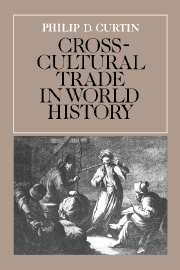Book contents
- Frontmatter
- Contents
- List of illustrations
- Preface
- 1 Trade diasporas and cross-cultural trade
- 2 Africa: incentives to trade, patterns of competition
- 3 Africa: traders and trade communities
- 4 Ancient trade
- 5 A new trade axis: the Mediterranean to China, circa 200 B.C. – A.D. 1000
- 6 Asian trade in Eastern seas, 1000–1500
- 7 The European entry into the trade of maritime Asia
- 8 Bugis, banians, and Chinese: Asian traders in the era of the great companies
- 9 Overland trade of the seventeenth century: Armenian carriers between Europe and East Asia
- 10 The North American fur trade
- 11 The twilight of the trade diasporas
- Bibliography
- Index
8 - Bugis, banians, and Chinese: Asian traders in the era of the great companies
Published online by Cambridge University Press: 15 March 2010
- Frontmatter
- Contents
- List of illustrations
- Preface
- 1 Trade diasporas and cross-cultural trade
- 2 Africa: incentives to trade, patterns of competition
- 3 Africa: traders and trade communities
- 4 Ancient trade
- 5 A new trade axis: the Mediterranean to China, circa 200 B.C. – A.D. 1000
- 6 Asian trade in Eastern seas, 1000–1500
- 7 The European entry into the trade of maritime Asia
- 8 Bugis, banians, and Chinese: Asian traders in the era of the great companies
- 9 Overland trade of the seventeenth century: Armenian carriers between Europe and East Asia
- 10 The North American fur trade
- 11 The twilight of the trade diasporas
- Bibliography
- Index
Summary
One of the historian's chronic problems is uneven source material. For certain times and places, the almost-accidental generation and preservation of historical records make possible a detailed reconstruction of the past. The geniza records of medieval Cairo are a good example. For other times and places, records are scarce. It is often hard to arrive at a balanced judgment between well-described and ill-described aspects of the past. It is therefore difficult to balance the Asian against the European contribution to the commercial history of maritime Asia before the late eighteenth century. The records of the great European companies are admirably preserved in the centralized archives of Europe. Those of Asian merchants were mainly private, and no one saw much use in keeping them beyond the era of the voyages and transactions they recorded. Asian, as well as European, historians have had to work from the European records, because they are the best we have for describing Asian commerce, even where Europeans were not directly involved.
As a result, the historical literature on maritime Asia in these centuries conveys the impression that the Europeans were the dynamic factor, directing and dominating trade, perhaps carrying most of it. That was simply not the case before the eighteenth century, a kind of transitional century into the “European Age” that was to come, even though the Dutch and English of the early seventeenth century did come to dominate the spice trade to Europe so effectively that spice caravans to the Mediterranean virtually disappeared. But the overland caravans on these and other routes still ran. They simply carried different goods.
- Type
- Chapter
- Information
- Cross-Cultural Trade in World History , pp. 158 - 178Publisher: Cambridge University PressPrint publication year: 1984
- 1
- Cited by



